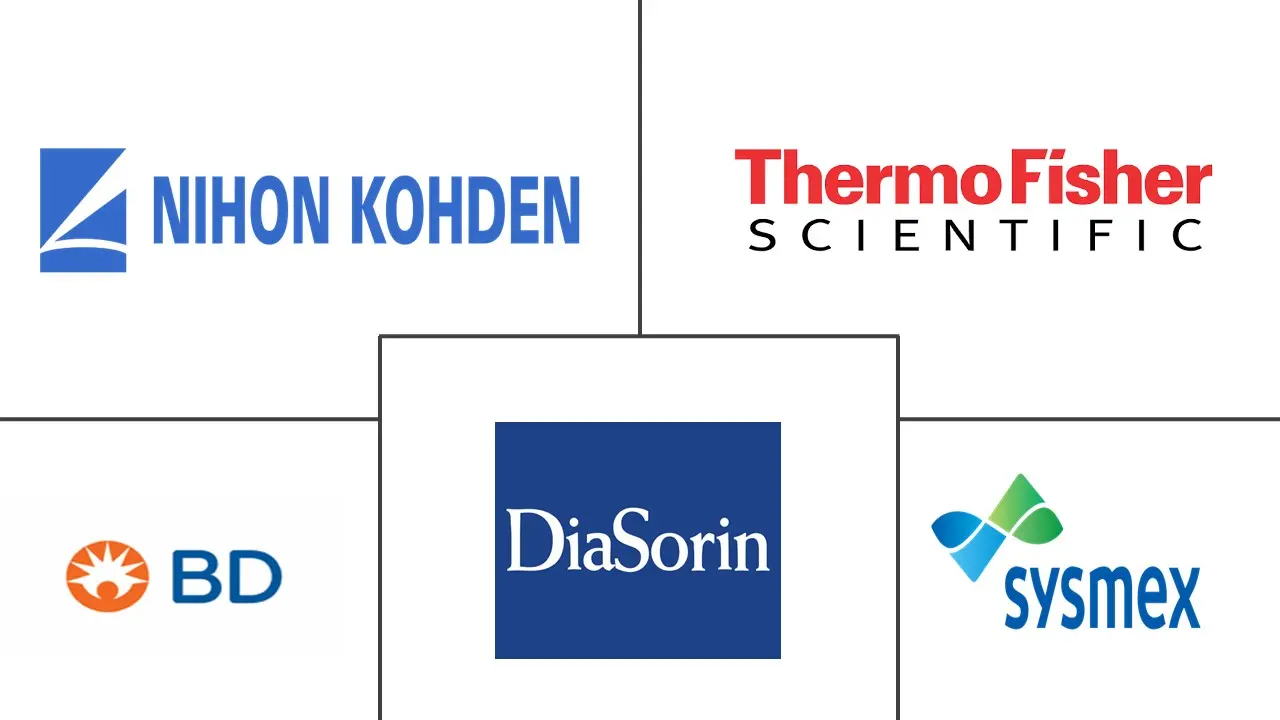Global Cell Surface Markers Detection Market Size and Share
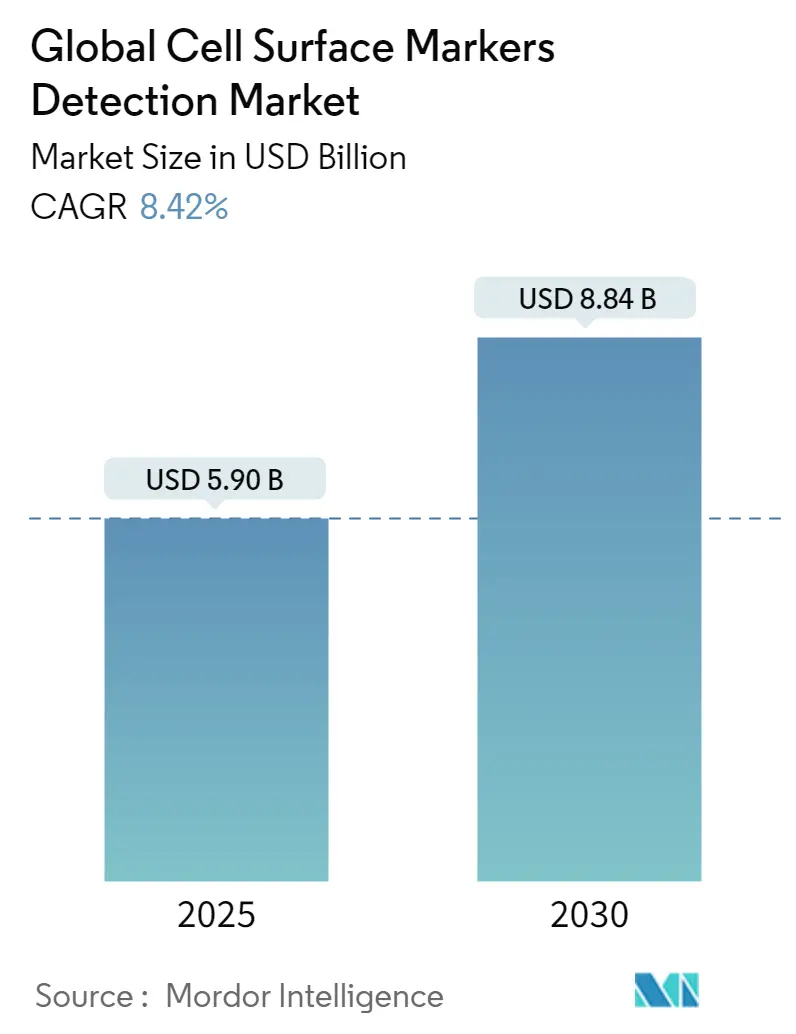
Global Cell Surface Markers Detection Market Analysis by Mordor Intelligence
The Global Cell Surface Markers Detection Market size is estimated at USD 5.90 billion in 2025, and is expected to reach USD 8.84 billion by 2030, at a CAGR of 8.42% during the forecast period (2025-2030).
The cell surface markers detection market is experiencing significant transformation through strategic consolidation and partnerships among key market players. Major companies are increasingly pursuing mergers and acquisitions to strengthen their market positions and expand technological capabilities. For instance, in July 2023, DiaSorin completed a strategic acquisition to strengthen its product portfolio in in-vitro diagnostics and gain access to advanced multiplexing technology. This trend of consolidation is reshaping the competitive landscape while fostering innovation through combined research and development capabilities. The industry has witnessed several similar strategic moves, indicating a shift toward more integrated and comprehensive solution offerings.
Research institutions and pharmaceutical companies are making substantial investments in cell surface marker research, particularly in oncology and stem cell applications. The Australian Government's Department of Health has committed approximately USD 150 million over nine years through its stem cell therapies mission, demonstrating the growing focus on research funding. Scientists have identified over 200 cell-surface markers that are overexpressed in various cancers, highlighting the expanding scope of research applications. This extensive research infrastructure is creating new opportunities for market players while advancing our understanding of cellular mechanisms and potential therapeutic applications.
The market is witnessing rapid advancement in detection technologies and methodologies, with a particular focus on improving accuracy and efficiency. Companies are developing innovative solutions that combine multiple detection methods, enabling more comprehensive cell analysis. For instance, in June 2023, Leica Microsystems launched the Leica Nano workflow, a new live-cell correlative light and electron microscopy solution designed to increase experimental success rates and improve reproducibility. These technological innovations are transforming how researchers and clinicians approach cell surface markers detection, leading to more reliable and efficient analysis methods.
Global healthcare infrastructure development is playing a crucial role in market expansion, particularly in emerging economies. Healthcare facilities are increasingly adopting advanced flow cytometry technologies to enhance their diagnostic and research capabilities. This trend is supported by growing investment in healthcare research facilities and the establishment of specialized research centers. For example, in October 2023, BD Life Sciences-Biosciences launched its second Center of Excellence in flow cytometry for clinical research in India, demonstrating the growing focus on expanding advanced research capabilities in developing markets. These developments are creating new market opportunities while improving access to advanced detection technologies across different regions.
Global Cell Surface Markers Detection Market Trends and Insights
Increased Use in Diagnostics
The use of cell surface markers in therapy, diagnosis, and prognosis has gained significant momentum over recent years, particularly in identifying and classifying various diseases. Cell surface markers serve as crucial monograms that help identify and classify cells, with proteins expressed on the surface of cancerous cells serving as markers for specific tumor types. For instance, over 200 cell-surface markers have been identified as being overexpressed in lung cancers, including markers like cytokeratin fragment 21-1 and EGFR gene mutation, which are instrumental in detecting the presence of tumor cells in blood through diagnostic procedures. These markers have become increasingly important in disease diagnoses, enabling direct treatment approaches and supporting drug discovery initiatives.
The application of cell surface markers extends beyond cancer detection to various other diagnostic areas, including immune system disorders and infectious diseases. Common cell surface markers such as CD3, CD4, CD8, and CD25 are routinely used to identify T cells and categorize them into cytotoxic, helper, and regulatory T cell subcategories. A number of cellular surface markers of human immunodeficiency virus (HIV) reservoirs have recently been proposed, including immune checkpoint molecules, CD2, and CD30, with CD32a emerging as one of the most promising HIV reservoir markers. The ability to determine the presence and quantity of certain types of cells in a sample has significant implications for diagnosis, drug development, clinical trial enrollment, and therapeutic decision-making processes. Techniques such as immunophenotyping and cell identification are increasingly utilized to enhance the precision of these diagnostic applications.
Technological Advances Related to Increased Throughput and Automation
The cell surface markers detection industry has witnessed significant technological advancement in recent years, particularly in automation and throughput capabilities of various diagnostic devices. Companies are continuously evolving their products and launching newer, more advanced systems that are not only efficient and accurate but can also streamline laboratory workflow through the automation of various procedures that were previously manually operated and time-consuming. For instance, advanced systems like the XF-1600 flow cytometer provide laboratories with improved flexibility and efficiency, offering seamless integration with other systems such as the PS-10 Sample Preparation System to automate the entire process of antibody staining, incubation, and flow cytometry analysis.
The introduction of sophisticated automated systems has revolutionized the field of cell surface markers detection by reducing manual intervention and improving accuracy. Modern analyzers like the DxH 560 AL with Auto-Loading functionality allow users to continually add up to 50 samples, provide safety against blood-borne pathogens, and significantly reduce time spent on manual instrument tasks. Similarly, innovations like the MEK-1305 Celltac α+ enable simultaneous CBC and ESR measurements in approximately two minutes with a single aspiration, requiring less blood sample volume than conventional methods. These technological advancements not only automate and streamline procedures but also save valuable laboratory space and time, contributing to overall operational efficiency. The integration of cellular imaging techniques further enhances the accuracy and reliability of these automated systems.
Increasing Demand for Precision Medicine
The growing emphasis on precision medicine has become a significant driver for the cell surface markers detection market, as it enables healthcare providers to develop targeted prevention and treatment plans based on individual variability in genes, environment, and lifestyle. Precision medicine requires developing a wide range of biomarker diagnostic assays that reflect individual differences, thus allowing tailored therapeutic interventions. Membrane proteins, which include approximately 30% of human proteins, play a crucial role in various pathological conditions and physiological functions, making them valuable targets for precision medicine applications.
The field has experienced tremendous growth since the milestone achievement of sequencing an entire human genome, with cancer treatment particularly benefiting from precision medicine therapies. Recent developments have focused on creating more accurate tumor models (organoids) and connecting the specificity of the immune system to develop effective cancer vaccines or monoclonal antibodies. Cell surface membrane proteins already serve as valuable prognostic and predictive biomarkers, particularly in hematological and immunological diseases, through the determination of cluster of differentiation markers. This approach allows healthcare providers to combine molecular data with an individual's medical history, circumstances, and values to develop targeted prevention and treatment plans, ultimately increasing the efficiency of the healthcare system by targeting treatments to only those patients who will benefit. The role of cell characterization and cell surface proteomics is pivotal in advancing these precision medicine strategies.
Segment Analysis: By Product
Flow Cytometry Segment in Cell Surface Markers Detection Market
Flow cytometry maintains its dominant position in the cell surface markers detection market, commanding approximately 39% of the total market share in 2024. This significant market presence is attributed to its versatile applications in cell counting, detecting biomarkers, cell sorting, and protein engineering. The technology's ability to detect and measure both physical and chemical characteristics of cell populations makes it indispensable in clinical laboratory settings. Flow cytometry's widespread adoption is further driven by its crucial role in immunophenotyping characterization of T, B, and natural killer cell subsets, enabling precise classification of patients with severe combined immunodeficiency into different categories. The technology's capability to provide multiple different techniques for assessing specific features of adaptive and innate immune function has established it as a cornerstone in cellular analysis and diagnostics.
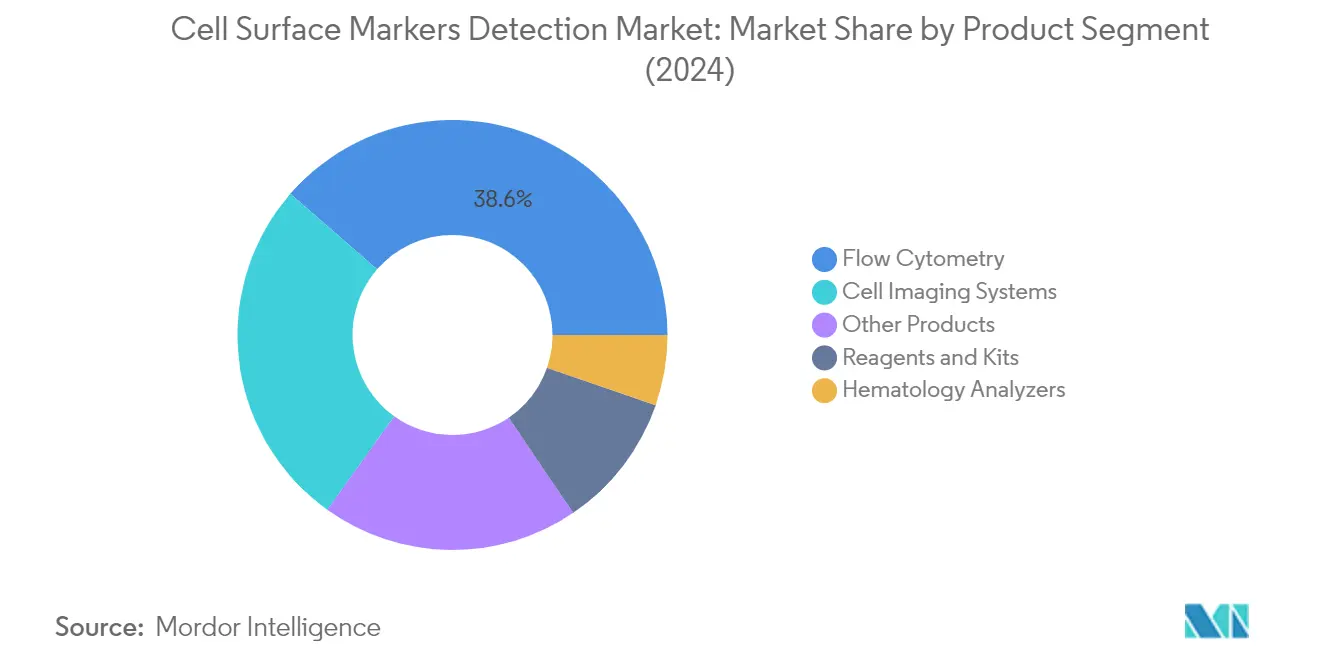
Cell Imaging Systems Segment in Cell Surface Markers Detection Market
The cell imaging systems segment is projected to experience the most robust growth in the cell surface markers detection market during the forecast period 2024-2029, with an expected growth rate of approximately 9% annually. This accelerated growth is driven by the segment's ability to enable real-time examination of cellular functions under both normal and experimental conditions. Cell imaging plays a pivotal role in drug discovery, optimization, and characterization at the single-cell level, while also facilitating the examination of effects on tissues and organs inside animal models. The segment's growth is further propelled by technological advancements in automated live-cell imaging systems designed for long-term experiments and comparison studies. The increasing adoption of high-content screening microscopy systems with environmental chambers and onboard pipetting capabilities demonstrates the growing preference for sophisticated cell imaging solutions in research and clinical applications.
Remaining Segments in Cell Surface Markers Detection Market
The cell surface markers detection market encompasses several other significant segments including reagents and kits, hematology analyzers, and other specialized products. Reagents and kits serve as integral components for diagnostics, offering a wide range of solutions for different types of disease diagnosis and complex biological sample analysis. Hematology analyzers contribute to the market by providing essential blood sample testing capabilities, including white blood cell counts, complete blood counts, and reticulocyte analysis. The other products segment includes various supporting technologies and tools that complement the primary analysis methods. These segments collectively enhance the market's capability to provide comprehensive cell analysis solutions across different applications and research requirements.
Segment Analysis: By Application
Drug Discovery Segment in Cell Surface Markers Detection Market
The Drug Discovery segment holds a significant position in the global cell surface markers detection market, accounting for approximately 32% of the total market share in 2024. This substantial market presence is driven by the increasing application of cell surface markers in developing new therapeutic approaches and identifying novel drug targets. The segment's growth is particularly notable in cancer research, where cell surface markers are crucial for developing targeted therapies and personalized medicine approaches. The ability to identify individual cells according to surface markers has enabled scientists to make significant breakthroughs in drug development, especially in areas like chemotherapeutic drug development and target identification. The pharmaceutical industry's continued focus on precision medicine and targeted therapies has further strengthened this segment's position in the market.
Disease Diagnosis and Identification Segment in Cell Surface Markers Detection Market
The Disease Diagnosis and Identification segment is experiencing robust growth in the cell surface markers detection market, with a projected growth rate of approximately 8% during the forecast period 2024-2029. This growth is primarily driven by the increasing adoption of cell surface markers in diagnostic procedures, particularly in cancer detection and immune system disorders. The segment's expansion is supported by technological advancements in diagnostic techniques and the growing demand for accurate and early disease detection methods. The rising prevalence of chronic diseases and the need for precise diagnostic tools have further accelerated the adoption of cell surface marker-based diagnostic solutions. Additionally, the segment is benefiting from increased healthcare spending and the growing emphasis on preventive healthcare measures across developed and developing regions.
Remaining Segments in Cell Surface Markers Detection Market
The Other Applications segment, which primarily includes research and academic applications, plays a vital role in shaping the cell surface markers detection market. This segment encompasses various applications such as stem cell research, immunology studies, and basic research in cellular biology. The segment's significance is underscored by the growing number of research projects worldwide focusing on understanding cellular mechanisms and developing new therapeutic approaches. Academic institutions and research laboratories continue to drive innovation in cell surface marker applications, contributing to the development of new methodologies and expanding the potential applications of these technologies. The segment also benefits from increasing public-private funding for cell surface marker-based research and the rising focus on biotechnology research and development.
Global Cell Surface Markers Detection Market Geography Segment Analysis
Cell Surface Markers Detection Market in North America
The North American cell surface markers detection market demonstrates robust growth driven by advanced healthcare infrastructure, significant research and development activities, and high adoption of innovative diagnostic technologies. The United States leads the regional market, followed by Canada and Mexico, with these countries showing varying levels of market maturity and growth potential. The presence of major market players, extensive clinical research activities, and a favorable regulatory environment contribute to the region's dominant position in the global market.
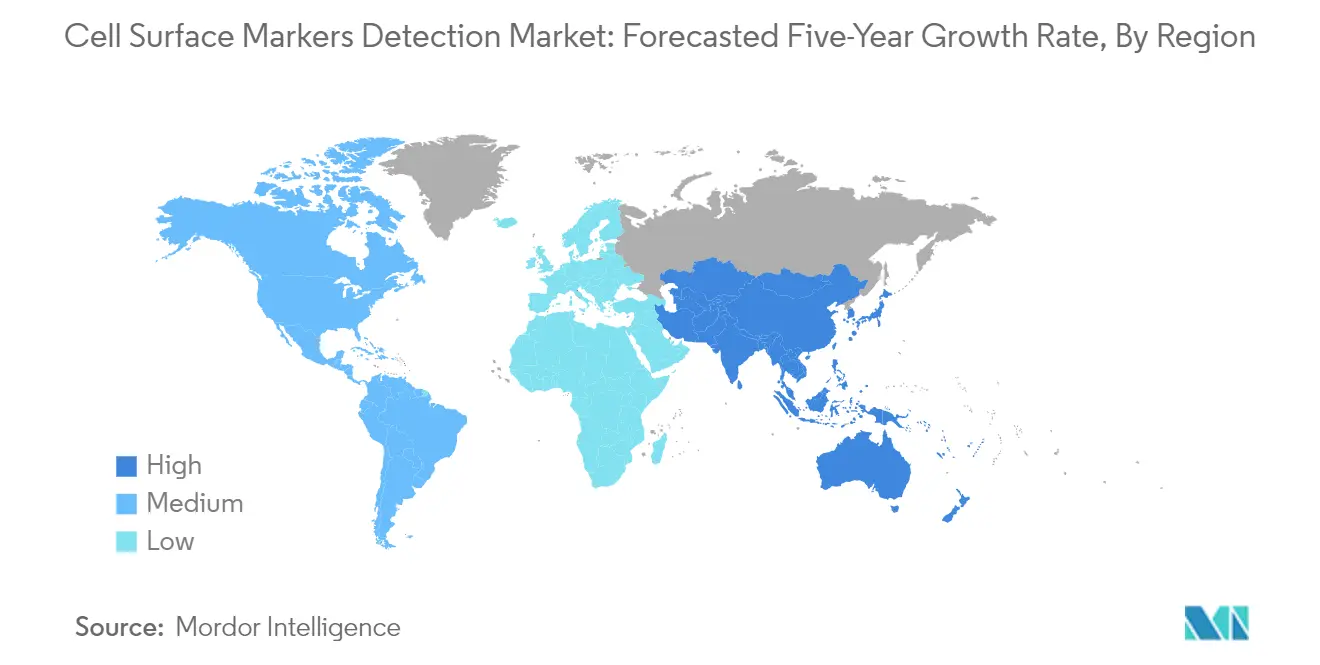
Cell Surface Markers Detection Market in United States
The United States maintains its position as the largest market for cell surface markers detection in North America, commanding approximately 40% of the regional market share. The country's market leadership is attributed to its extensive network of research institutions, high healthcare expenditure, and strong presence of pharmaceutical and biotechnology companies. The rising burden of chronic diseases, particularly cancer and autoimmune disorders, drives the demand for advanced diagnostic solutions. The country's robust healthcare infrastructure and continuous technological advancements in diagnostic techniques further strengthen its market position.
Cell Surface Markers Detection Market Growth Dynamics in United States
The United States also demonstrates strong growth potential with an expected CAGR of approximately 9% during 2024-2029. This growth is fueled by increasing investment in precision medicine initiatives, rising demand for advanced diagnostic solutions, and growing adoption of flow cytometry techniques in research and clinical applications. The country's focus on developing innovative diagnostic solutions, coupled with increasing healthcare expenditure and rising awareness about early disease detection, continues to drive market expansion.
Cell Surface Markers Detection Market in Europe
The European cell surface markers detection market exhibits strong growth dynamics supported by well-established healthcare systems, significant research activities, and an increasing focus on precision medicine. The region benefits from the presence of major market players, advanced research facilities, and supportive healthcare policies. Key markets including the United Kingdom, Germany, France, Italy, and Spain contribute significantly to the regional market growth, each bringing unique strengths in terms of research capabilities and healthcare infrastructure.
Cell Surface Markers Detection Market in United Kingdom
The United Kingdom emerges as the largest market for cell surface markers detection in Europe, holding approximately 26% of the regional market share. The country's leading position is supported by its strong emphasis on medical research, substantial healthcare spending, and the presence of world-class research institutions. The UK's robust pharmaceutical and biotechnology sectors, coupled with increasing investment in diagnostic technologies, contribute to its market dominance in the region.
Cell Surface Markers Detection Market Growth Dynamics in France
France demonstrates the highest growth potential in the European region, with an anticipated CAGR of approximately 9% during 2024-2029. The country's impressive growth trajectory is driven by increasing investment in healthcare infrastructure, rising adoption of advanced diagnostic technologies, and a growing focus on personalized medicine. France's strong commitment to medical research and development, coupled with supportive government initiatives for healthcare innovation, positions it as a key growth market in the region.
Cell Surface Markers Detection Market in Asia-Pacific
The Asia-Pacific region represents a dynamic market for cell surface markers detection, characterized by rapidly evolving healthcare infrastructure, increasing research activities, and growing adoption of advanced diagnostic technologies. Countries such as China, Japan, India, Australia, and South Korea are making significant strides in developing their healthcare and research capabilities. The region's large patient population, increasing healthcare expenditure, and growing focus on early disease detection create substantial opportunities for market expansion.
Cell Surface Markers Detection Market in China
China emerges as the dominant market for cell surface markers detection in the Asia-Pacific region. The country's market leadership is driven by its large population base, rapidly expanding healthcare infrastructure, and increasing investment in medical research and development. China's growing focus on precision medicine, coupled with rising healthcare expenditure and an expanding biotechnology sector, reinforces its position as a key market in the region.
Cell Surface Markers Detection Market Growth Dynamics in India
India demonstrates remarkable growth potential in the cell surface markers detection market. The country's growth is fueled by increasing healthcare awareness, expanding research infrastructure, and rising investment in diagnostic technologies. The government's focus on improving healthcare accessibility, coupled with growing private sector participation in healthcare services, creates favorable conditions for market expansion. India's large patient population and increasing adoption of advanced diagnostic techniques further contribute to its growth trajectory.
Cell Surface Markers Detection Market in Middle East & Africa
The Middle East & Africa region presents growing opportunities in the cell surface markers detection market, with varying levels of market development across different countries. The GCC countries and South Africa represent key markets in the region, with GCC emerging as the largest market while South Africa shows promising growth potential. The region's market growth is driven by improving healthcare infrastructure, increasing healthcare spending, and growing awareness about advanced diagnostic technologies. Government initiatives to enhance healthcare services and rising investment in medical research contribute to the market's development.
Cell Surface Markers Detection Market in South America
The South American cell surface markers detection market demonstrates steady growth potential, with Brazil and Argentina emerging as key markets in the region. Brazil represents the largest market in the region, while also showing the highest growth potential. The region's market development is supported by increasing healthcare expenditure, growing research activities, and rising adoption of advanced diagnostic technologies. The presence of well-established healthcare facilities in major cities, coupled with increasing focus on early disease detection and diagnosis, drives market growth. Government initiatives to improve healthcare infrastructure and rising investment in medical research further contribute to market expansion.
Competitive Landscape
Top Companies in Cell Surface Markers Detection Market
The cell surface markers detection market features prominent players like Abbott Laboratories, Danaher Corporation, Becton Dickinson and Company, Bio-Rad Laboratories, and Thermo Fisher Scientific, leading the innovation curve. These companies are heavily investing in research and development to introduce advanced automated systems with improved throughput capabilities and enhanced precision. Strategic partnerships and collaborations with research institutions and healthcare facilities have become increasingly common to expand product applications and market reach. Companies are focusing on developing integrated workflow solutions that combine instruments, reagents, and software platforms to provide comprehensive cell analysis capabilities. The market is characterized by continuous product launches featuring technological advancements such as improved sensitivity, multiplexing capabilities, and automated sample preparation systems, while geographical expansion through distribution networks and local manufacturing facilities remains a key growth strategy.
Consolidated Market with Strong M&A Activity
The cell surface markers detection market exhibits a moderately consolidated structure dominated by large multinational corporations with diverse product portfolios spanning multiple segments of the diagnostics and life sciences industry. These established players leverage their extensive research capabilities, global distribution networks, and strong financial positions to maintain market leadership. The market has witnessed significant merger and acquisition activity, with larger companies acquiring specialized technology providers and regional players to expand their product offerings and geographical presence. Companies like Danaher Corporation and Thermo Fisher Scientific have been particularly active in strategic acquisitions to strengthen their market positions and acquire innovative technologies.
The competitive dynamics are shaped by high entry barriers due to significant capital requirements, regulatory compliance needs, and the importance of established customer relationships in the healthcare and research sectors. Regional players and specialized companies maintain their presence through a focus on specific market segments or geographical regions, often competing through specialized product offerings and local market expertise. The market also sees strategic collaborations between diagnostic companies and research institutions, creating a complex web of partnerships that drives innovation and market expansion.
Innovation and Integration Drive Future Success
Success in the cell surface markers detection market increasingly depends on companies' ability to develop integrated solutions that address the growing demand for automation and precision in clinical diagnostics and research applications. Market leaders are focusing on developing comprehensive platforms that combine multiple technologies and offer seamless workflow integration, while emerging players are finding opportunities in specialized applications and novel detection technologies. The ability to provide end-to-end solutions, from sample preparation to data analysis, along with strong technical support and service capabilities, has become crucial for maintaining a competitive advantage. Companies are also investing in digital capabilities and data management solutions to meet the evolving needs of healthcare providers and research institutions.
Future market success will be significantly influenced by companies' ability to navigate regulatory requirements while maintaining innovation momentum. The increasing focus on personalized medicine and precision diagnostics creates opportunities for companies that can develop targeted solutions for specific applications. Market players must also address the growing demand for cost-effective solutions while maintaining product quality and performance standards. Building strong relationships with key opinion leaders and research institutions remains crucial for product validation and market acceptance. Companies that can successfully balance innovation, regulatory compliance, and market access while maintaining operational efficiency are likely to emerge as market leaders in the evolving competitive landscape. The integration of flow cytometry and immunoassay technologies into comprehensive platforms is becoming increasingly important for achieving precise cell characterization and cellular imaging, which are critical for advancing personalized medicine.
Global Cell Surface Markers Detection Industry Leaders
-
Becton, Dickinson and Company
-
Nihon Kohden Corporation
-
Sysmex Corporation
-
Diasorin SpA (Luminex Corporation)
-
Thermo Fisher Scientific Inc.
- *Disclaimer: Major Players sorted in no particular order
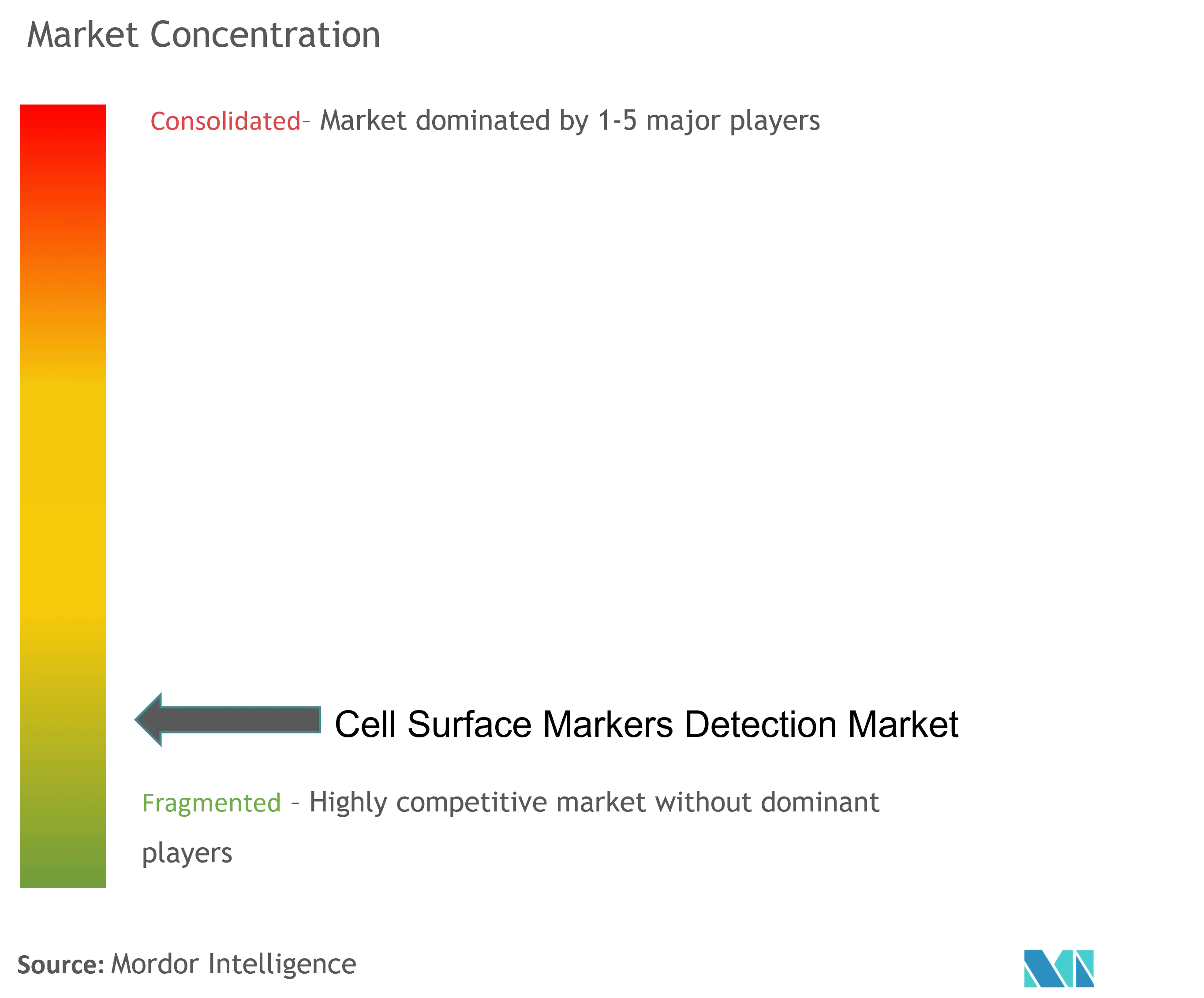
Recent Industry Developments
- April 2022: Sysmex Europe, a provider of automated workflow solutions in the disciplines of hematology, urinalysis, and hemostasis, has reported the launch of its Flow Cytometer XF-1600, which has received CE marking, indicating its compliance with the European IVD Regulation and IVD use.
- April 2022: CytoSMART Technologies, an Axion Bio company, launched the CytoSMART Omni FL, a next-generation live-cell imaging analysis system incorporating red and green fluorescence channels into its signature CytoSMART Omni product line for the first time. The advance reflects the company's ongoing commitment to providing high-quality, accessible live-cell imaging to every cell biology lab and offers an innovative platform for researchers in stem cell biology, immuno-oncology, virology, toxicology, neurology, and other fields.
Global Cell Surface Markers Detection Market Report Scope
As per the scope of this report, cell surface markers detection refers to the separation and identification of target cells using analytical methods and processes, such as flow cytometry. The Cell Surface Markers Detection Market is segmented by Product (Flow Cytometry, Hematology Analyzers, Cell Imaging Systems, Reagents and Kits, and Other Products), Application (Disease Diagnosis and Identification, Research, and Drug Discovery, and Other Applications), and Geography (North America, Europe, Asia-Pacific, Middle East and Africa, and South America). The market report also covers the estimated market sizes and trends for 17 countries across major regions globally. The report offers the value in USD million for the above segments.
| Flow Cytometry |
| Hematology Analyzers |
| Cell Imaging Systems |
| Reagents and Kits |
| Other Products |
| Disease Diagnosis and Identification |
| Research and Drug Discovery |
| Other Applications |
| North America | United States |
| Canada | |
| Mexico | |
| Europe | Germany |
| United Kingdom | |
| France | |
| Italy | |
| Spain | |
| Rest of Europe | |
| Asia-Pacific | China |
| Japan | |
| India | |
| Australia | |
| South Korea | |
| Rest of Asia-Pacific | |
| Middle East and Africa | GCC |
| South Africa | |
| Rest of Middle East and Africa | |
| South America | Brazil |
| Argentina | |
| Rest of South America |
| Product | Flow Cytometry | |
| Hematology Analyzers | ||
| Cell Imaging Systems | ||
| Reagents and Kits | ||
| Other Products | ||
| Application | Disease Diagnosis and Identification | |
| Research and Drug Discovery | ||
| Other Applications | ||
| Geography | North America | United States |
| Canada | ||
| Mexico | ||
| Europe | Germany | |
| United Kingdom | ||
| France | ||
| Italy | ||
| Spain | ||
| Rest of Europe | ||
| Asia-Pacific | China | |
| Japan | ||
| India | ||
| Australia | ||
| South Korea | ||
| Rest of Asia-Pacific | ||
| Middle East and Africa | GCC | |
| South Africa | ||
| Rest of Middle East and Africa | ||
| South America | Brazil | |
| Argentina | ||
| Rest of South America | ||
Key Questions Answered in the Report
How big is the Global Cell Surface Markers Detection Market?
The Global Cell Surface Markers Detection Market size is expected to reach USD 5.90 billion in 2025 and grow at a CAGR of 8.42% to reach USD 8.84 billion by 2030.
What is the current Global Cell Surface Markers Detection Market size?
In 2025, the Global Cell Surface Markers Detection Market size is expected to reach USD 5.90 billion.
Who are the key players in Global Cell Surface Markers Detection Market?
Becton, Dickinson and Company, Nihon Kohden Corporation, Sysmex Corporation, Diasorin SpA (Luminex Corporation) and Thermo Fisher Scientific Inc. are the major companies operating in the Global Cell Surface Markers Detection Market.
Which is the fastest growing region in Global Cell Surface Markers Detection Market?
Asia-Pacific is estimated to grow at the highest CAGR over the forecast period (2025-2030).
Which region has the biggest share in Global Cell Surface Markers Detection Market?
In 2025, the North America accounts for the largest market share in Global Cell Surface Markers Detection Market.
What years does this Global Cell Surface Markers Detection Market cover, and what was the market size in 2024?
In 2024, the Global Cell Surface Markers Detection Market size was estimated at USD 5.40 billion. The report covers the Global Cell Surface Markers Detection Market historical market size for years: 2019, 2020, 2021, 2022, 2023 and 2024. The report also forecasts the Global Cell Surface Markers Detection Market size for years: 2025, 2026, 2027, 2028, 2029 and 2030.
Page last updated on:
